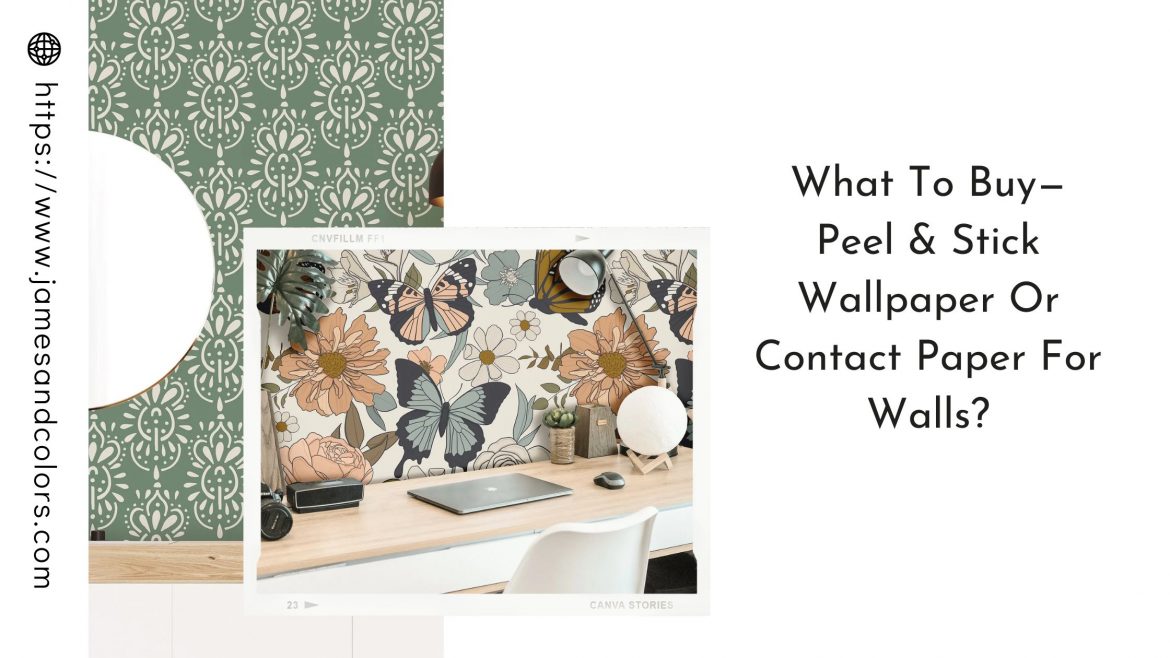Peel and stick wallpaper is almost the same as contact paper. However, the former is not yet a popular method of decorating walls. The former is made of a thin layer of polyester bonded to a backing of vinyl. This process makes it easy to remove from the wall whenever needed. You can apply this type of wall covering to the walls by easily peeling and sticking the paper to the wall. The significant difference between the both is that the former can be removed easily from the wall while the latter cannot.
Peel and Stick Wallpapers have recently gained popularity, just 4-5 years back. But contact paper has been around practically for more than 4-5 decades now. I was in the middle of redoing my bedroom, which got me thinking if peel and stick wallpaper is the same as contact paper. If not, what’s the difference?
After digging some research, I concluded that both wallpapers are similar as both are paper or vinyl-based products with a decorative contact paper front and an adhesive backing. The major difference between them resides in their installation methods. You can paste this paper preferably on horizontal surfaces and another wallpaper preferably on vertical surfaces.
But, wait, your search doesn’t end here! Another part of the story tells you about some subtle differences. Continue reading this blog to find out how the two are similar and different, what they are made of, how efficient their removal is, how each of them will hold up in a bathroom, and much more.
Let’s get started.
What is Contact Paper? What is it made of?
Contact paper generally has a strong adhesive on one side and a decorative or patterned print on the other. It’s usually available in roll form, and you often find it in the kitchen area of your local big box store.
Depending on its type, it can be made from a few materials, though vinyl goes into its making most of the time. Vinyl is just a concise way to refer to polyvinyl chloride or PVC, a synthetic material made from a complicated process of combining natural gas, petroleum, seawater, oil, and industrial-grade salt. Almost all adhesives used are water-based, so they’re easy to remove, but finding out what goes into its making has been challenging.
Applications Of Contact Paper
You can use self-adhesive paper for many projects around your home, such as covering countertops in the old kitchen with decorative contact paper, etc. Moreover, you can also install window film paper in bathrooms for privacy. Here are a few more tips that tell you how to use contact paper:
- Resurfacing furniture, countertops, or other flat surfaces
- Providing privacy in a bathroom window
- As a backsplash in a bookshelf
- Covering old appliances
- To create a chalkboard
- As a backsplash in your kitchen
- On patio doors to keep the scorching sun out or get more privacy.
- Refurbish old floors to give them a new look
And much More.
What is Peel and Stick Wallpaper? What is it made of?
Peel and stick wallpaper has an adhesive backing and a paper front, making it possible to hang it without typical wallpaper paste. Its simplicity of installation, affordability, and detachable nature has contributed to its popularity in recent years.
Although various sources are available online, you can easily find contact paper in the home decor areas of big box stores.
There are peel-and-stick wallpaper options without PVC, although some contain PVC. Peel and stick wallpaper is unquestionably the way to go (rather than contact paper for walls) if you’re concerned about your environmental effect because it’s significantly better for the environment. Visit JamesAndColors immediately to browse their fantastic variety of PVC-free, lead-free, VOC-free, and non-toxic wallpapers!
Applications Of Peel & Stick Wallpaper
Most peel and stick wallpaper serves the purpose of decorating walls, but you can use it in other ways.
- As a backsplash on a bookshelf
- As a backsplash
- On stair risers
- On pretty much any vertical surface
Anywhere that has a low traffic area or low contact surface is a good place to apply peel and stick wallpaper. It wouldn’t hold up well when placed on a floor or a frequently-used shelf, but it’s a terrific choice for enhancing architectural details like nooks, crannies, and ceilings.
Are both waterproof?
Vinyl, the material used to make self-adhesive paper, is entirely waterproof. However, since almost all of the adhesives used to make self-adhesive paper are water-based, any contact with the moisture concealed by the vinyl backing would result in installation failure.
A few people have used silicone caulk to seal the borders of the contact paper to create waterproof installations, but it is a permanent fix for what is often a fairly temporary product.
However, peel and stick wallpaper is not waterproof, though it can only bear a few splashes here and there. If you’re looking to install a waterproof wall covering, peel and stick wallpaper shouldn’t be your first choice.
Wrapping up!
Peel and stick wallpaper and contact paper are very similar but have different uses. However, self-adhesive paper is more versatile and flexible but not environment-friendly. So, while you technically can use peel and stick wallpaper instead of self-adhesive paper, you may find the wallpaper thinner and less durable. After all, it is intended to go on walls, not line your kitchen drawers. In short, you can definitely use contact paper as peel and stick wallpaper.
Also Read : 10 things to avoid when decorating your home


